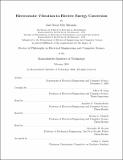Electrostatic vibration-to-electric energy conversion
Author(s)
Mur Miranda, José Oscar, 1972-
DownloadFull printable version (2.819Mb)
Other Contributors
Massachusetts Institute of Technology. Dept. of Electrical Engineering and Computer Science.
Advisor
Jeffrey H. Lang.
Terms of use
Metadata
Show full item recordAbstract
Ultra-Low-Power electronics can perform useful functions with power levels as low as 170 nW. This makes them amenable to powering from ambient sources such as vibration. In this case, they can become autonomous. Motivated by this application, this thesis provides the necessary tools to analyze, design and fabricate MEMS devices capable of electrostatic vibration-to-electric energy conversion at the microwatt level. The fundamental means of en- ergy conversion is a variable capacitor that is excited through a generating energy conversion cycle with every vibration cycle of the converter. This thesis presents a road map on how to design MEMS electrostatic vibration-to- electric energy converters. A proposed converter is designed to illustrate the design process, and is based on vibration levels typical of rotating machinery, which are around 2% of the acceleration of gravity from 1-5 kHz. The converter consists of a square centimeter with a 195 mg proof mass which travels ±200 pm. This mass and travel can couple to a sinusoidal acceleration source of 0.02g at 2.5 kHz, typical of rotating machinery, so as to capture 24 nJ per cycle. This moving proof mass is designed to provide a variable capacitor ranging from 1 pF to 80 pF. Adding a capacitor of 88 pF in parallel with this device will result in a capacitance change from 168 pF to 89 pF that is required to extract 24 nJ using a charge-constrained cycle. (cont.) This device can be attached to power electronics that implement a charge-constrained cycle and deliver 0.5 nJ back to the reservoir for a total power output of 1.3 [mu]/W at 2.5 kHz. The efficiency of the electrical conversion is 2%. Including packaging, the power per volume would be 0.87 [mu]W/cm3 and the power per mass would be 1.3 [mu]W/g. System improvements are also identified such as those that address the principal sources of loss. For example, decreasing the output capacitance of the MOSFET switches from 10 pF to 1 pF, while keeping the energy conversion cycle the same, results in an energy output of 13 nJ out of 24 nJ, for an efficiency of 54% and a power output of 33 [mu]W. This argues strongly for the use of integrated circuits in which the output capacitance of the MOSFET switches can be reduced for this application.
Description
Thesis (Ph. D.)--Massachusetts Institute of Technology, Dept. of Electrical Engineering and Computer Science, 2004. Includes bibliographical references (p. 193-197). This electronic version was submitted by the student author. The certified thesis is available in the Institute Archives and Special Collections.
Date issued
2004Department
Massachusetts Institute of Technology. Department of Electrical Engineering and Computer SciencePublisher
Massachusetts Institute of Technology
Keywords
Electrical Engineering and Computer Science.